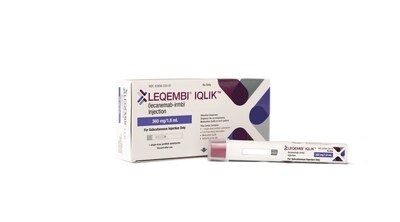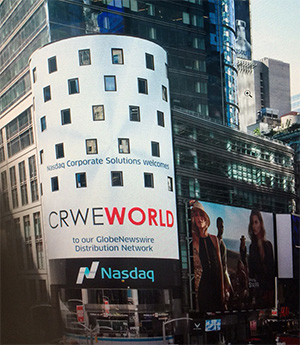Eisai and Biogen Announce U.S. Availability of LEQEMBI® IQLIK™ (lecanemab-irmb) Subcutaneous Injection Maintenance Dose for Treatment of Early Alzheimer's Disease
Eisai and Biogen Announce U.S. Availability of LEQEMBI® IQLIK™ (lecanemab-irmb) Subcutaneous Injection Maintenance Dose for Treatment of Early Alzheimer's Disease |
| [06-October-2025] |
New LEQEMBI CompanionTM program launched to expand helpful resources for patients throughout the treatment journey, including Nurse Educators who can provide patients with injection training, and an injection tracking tool and more LEQEMBI IQLIK, approved by the U.S. FDA in August 2025, is the first and only anti-amyloid treatment to offer an at-home injection after initial treatment of 18 months TOKYO and CAMBRIDGE, Mass., Oct. 6, 2025 /PRNewswire/ -- Eisai Co., Ltd. (Headquarters: Tokyo, CEO: Haruo Naito, "Eisai") and Biogen Inc. (Nasdaq: BIIB, Headquarters: Cambridge, Massachusetts, CEO: Christopher A. Viehbacher, "Biogen") announced today that lecanemab-irmb subcutaneous injection (U.S. brand name: LEQEMBI® IQLIKTM) is now available in the U.S. as a maintenance dosing regimen for the treatment of Alzheimer's disease (AD) in patients with Mild Cognitive Impairment (MCI) or mild dementia stage of disease (collectively referred to as early AD). After 18 months of LEQEMBI (lecanemab-irmb) intravenous (IV) treatment at 10 mg/kg every two weeks, patients may either continue IV infusions at 10 mg/kg once every four weeks or start the new weekly 360 mg subcutaneous injection using the LEQEMBI IQLIK autoinjector. Eisai and Biogen have also launched the LEQEMBI CompanionTM program, an initiative rooted in both companies' commitment to providing access to LEQEMBI and resources for people living with early Alzheimer's disease. The program aims to provide expanded resources that support patients throughout their LEQEMBI treatment journey, from initiation through maintenance therapy. In addition to the current resources already provided (e.g., help with understanding insurance coverage and potential out-of-pocket costs and identifying financial support programs), the new LEQEMBI Companion program will now offer patients:
Designed to serve as a digital solution to help support patients and care partners along their treatment journey, the LEQEMBI Companion app was developed with Medisafe, a digital patient engagement and medication management platform. From educational information about the injection process to a tool for tracking where and when injections occur, the LEQEMBI Companion app offers resources and more all in one place. Patients can visit LEQEMBI.com/CompanionAppSignUp to get started. To further support access to LEQEMBI for certain patients who need help paying for their medicines, Eisai's Patient Assistance Program (PAP) will provide LEQEMBI and LEQEMBI IQLIK at no cost, for eligible uninsured and underinsured patients, who meet financial need and other program criteria. To learn more, or if you are already enrolled and have questions, visit LEQEMBI.com/PatientSupport or call 1-833-4-LEQEMBI (1-833-453-7362), Monday-Friday, 8 a.m. to 8 p.m. Eastern Time. AD is a progressive, relentless disease characterized by formation of protein deposits known as plaques made of amyloid-beta aggregates and neurofibrillary tangles made of tau protein in the brains of people living with AD. It is caused by a continuous underlying neurotoxic process that begins before amyloid plaque accumulation and continues after plaque removal.1-3 The data show that amyloid-beta protofibrils and tau tangles play roles in the neurodegeneration process,4-6 and only LEQEMBI fights AD in two ways – targeting both amyloid plaque and protofibrils*, which can impact tau downstream. Due to the reaccumulation of AD biomarkers and return to placebo rate of decline after therapy is stopped,4-5 continuing maintenance treatment after the initial 18-month therapy is essential to slow the progression of AD and extend the therapeutic benefits, helping patients maintain who they are for longer. The availability of LEQEMBI IQLIK in the U.S. offers patients and care partners the ability to use the device at home, shortening treatment time, and providing an option to continue treatment without having to worry about visiting an infusion center. The LEQEMBI IQLIK also has the potential to reduce healthcare resources associated with IV maintenance dosing, such as preparation for infusion and nurse monitoring, while increasing infusion capacity for new eligible patients to begin initiation treatment and streamlining the overall AD treatment pathway. Eisai serves as the lead for lecanemab's development and regulatory submissions globally with Eisai and Biogen co-commercializing and co-promoting the product and Eisai having final decision-making authority. * Protofibrils are thought to be the most toxic Aβ species that contribute to brain damage in AD and play a major role in the cognitive decline of this progressive and devastating disease. Protofibrils can cause neuronal and synaptic damage in the brain, which can subsequently adversely affect cognitive function through multiple mechanisms.6 The mechanism by which this occurs has been reported not only by increasing the formation of insoluble Aβ plaques, but also by directly damaging signaling between neurons and other cells. It is believed that reducing protofibrils may reduce neuronal damage and cognitive impairment, potentially preventing the progression of AD.5 INDICATION LEQEMBI® is indicated for the treatment of Alzheimer's disease (AD). Treatment with LEQEMBI should be initiated in patients with mild cognitive impairment (MCI) or mild dementia stage of disease, the population in which treatment was initiated in clinical trials. IMPORTANT SAFETY INFORMATION
C ONTRAINDICATION Contraindicated in patients with serious hypersensitivity to lecanemab-irmb or to any of the excipients. Reactions have included angioedema and anaphylaxis. WARNINGS AND PRECAUTIONS AMYLOID-RELATED IMAGING ABNORMALITIES Medications in this class, including LEQEMBI, can cause ARIA-E, which can be observed on MRI as brain edema or sulcal effusions, and ARIA-H, which includes microhemorrhage and superficial siderosis. ARIA can occur spontaneously in patients with AD, particularly in patients with MRI findings suggestive of cerebral amyloid angiopathy (CAA), such as pretreatment microhemorrhage or superficial siderosis. ARIA-H generally occurs with ARIA-E. Reported ARIA symptoms may include headache, confusion, visual changes, dizziness, nausea, and gait difficulty. Focal neurologic deficits may also occur. Symptoms usually resolve over time. Incidence of ARIA Incidence of ICH Risk Factors of ARIA and ICH Radiographic Findings of CAA The baseline presence of at least 2 microhemorrhages or the presence of at least 1 area of superficial siderosis on MRI, which may be suggestive of CAA, have been identified as risk factors for ARIA. Patients were excluded from Clarity AD for the presence of >4 microhemorrhages and additional findings suggestive of CAA (prior cerebral hemorrhage >1 cm in greatest diameter, superficial siderosis, vasogenic edema) or other lesions (aneurysm, vascular malformation) that could potentially increase the risk of ICH. Concomitant Antithrombotic or Thrombolytic Medication Fatal cerebral hemorrhage has occurred in 1 patient taking an anti-amyloid monoclonal antibody in the setting of focal neurologic symptoms of ARIA and the use of a thrombolytic agent. Additional caution should be exercised when considering the administration of antithrombotics or a thrombolytic agent (e.g., tissue plasminogen activator) to a patient already being treated with LEQEMBI. Because ARIA-E can cause focal neurologic deficits that can mimic an ischemic stroke, treating clinicians should consider whether such symptoms could be due to ARIA-E before giving thrombolytic therapy in a patient being treated with LEQEMBI. Caution should be exercised when considering the use of LEQEMBI in patients with factors that indicate an increased risk for ICH and, in particular, patients who need to be on anticoagulant therapy or patients with findings on MRI that are suggestive of CAA. Radiographic Severity With LEQEMBI Monitoring and Dose Management Guidelines HYPERSENSITIVITY REACTIONS Hypersensitivity reactions, including angioedema, bronchospasm, and anaphylaxis, have occurred with LEQEMBI. Promptly discontinue the infusion upon the first observation of any signs or symptoms consistent with a hypersensitivity reaction and initiate appropriate therapy. INFUSION-RELATED REACTIONS (IRR s) IRRs were observed—LEQEMBI: 26%; placebo: 7%—and most cases with LEQEMBI (75%) occurred with the first infusion. IRRs were mostly mild (69%) or moderate (28%). Symptoms included fever and flu-like symptoms (chills, generalized aches, feeling shaky, and joint pain), nausea, vomiting, hypotension, hypertension, and oxygen desaturation. IRRs can occur during or after the completion of infusion. In the event of an IRR during the infusion, the infusion rate may be reduced or discontinued, and appropriate therapy initiated as clinically indicated. Consider prophylactic treatment prior to future infusions with antihistamines, acetaminophen, nonsteroidal anti-inflammatory drugs, or corticosteroids. ADVERSE REACTIONS
LEQEMBI (lecanemab-irmb) is available:
Please see full Prescribing Information for LEQEMBI, including Boxed WARNING.
Notes to Editors 1. About lecanemab (generic name, brand name: LEQEMBI ®) Lecanemab has been approved in 50 countries and is under regulatory review in 8 countries. In January 2025, the supplemental Biologics License Application (sBLA) for intravenous (IV) maintenance dosing of the treatment was approved in the U.S., and application have been filed in nine (9) countries and regions. LEQEMBI's approvals in these countries was based on Phase 3 data from Eisai's, global Clarity AD clinical trial, in which it met its primary endpoint and all key secondary endpoints with statistically significant results. The primary endpoint was the global cognitive and functional scale, Clinical Dementia Rating Sum of Boxes (CDR-SB). In the Clarity AD clinical trial, treatment with lecanemab reduced clinical decline on CDR-SB by 27% at 18 months compared to placebo. The mean CDR-SB score at baseline was approximately 3.2 in both groups. The adjusted least-squares mean change from baseline at 18 months was 1.21 with lecanemab and 1.66 with placebo (difference, −0.45; 95% confidence interval [CI], −0.67 to −0.23; P<0.001). In addition, the secondary endpoint from the AD Cooperative Study-Activities of Daily Living Scale for Mild Cognitive Impairment (ADCS-MCI-ADL), which measures information provided by people caring for patients with AD, noted a statistically significant benefit of 37% compared to placebo. The adjusted mean change from baseline at 18 months in the ADCS-MCI-ADL score was −3.5 in the lecanemab group and −5.5 in the placebo group (difference, 2.0; 95% CI, 1.2 to 2.8; P<0.001). The ADCS MCI-ADL assesses the ability of patients to function independently, including being able to dress, feed themselves and participate in community activities. The most common adverse events (>10%) in the lecanemab group were infusion reactions, ARIA-H (combined cerebral microhemorrhages, cerebral macrohemorrhages, and superficial siderosis), ARIA-E (edema/effusion), headache, and fall. The subcutaneous maintenance dosing approval is based on LEQEMBI subcutaneous (SC) sub-studies of the Phase 3 Clarity AD open-label extension (OLE) trial in individuals with early AD which evaluated a range of subcutaneous doses. Data shows that transitioning to the weekly LEQEMBI IQLIK autoinjector after 18 months of the initiation dose (10 mg/kg IV every two weeks) maintains clinical and biomarker benefits comparable to continued IV dosing. The safety of LEQEMBI IQLIK autoinjector was studied in over 600 patients at a range of doses as part of the Clarity AD OLE. Across all subcutaneous doses, the safety profile was similar to that of the IV maintenance treatment with one key difference: systemic reactions were much less common with subcutaneous dosing—less than 1% compared to approximately 26% with IV infusions. ARIA rates in patients who received a weekly 360 mg subcutaneous maintenance dose were similar to ARIA rates reported in patients who continued with the IV dose after 18 months and are similar to the background rates of ARIA in patients without treatment. Since July 2020, the Phase 3 clinical study (AHEAD 3-45) for individuals with preclinical AD, meaning they are clinically normal and have intermediate or elevated levels of amyloid in their brains, is ongoing. AHEAD 3-45 is conducted as a public-private partnership between the Alzheimer's Clinical Trial Consortium that provides the infrastructure for academic clinical trials in AD and related dementias in the U.S, funded by the National Institute on Aging, part of the National Institutes of Health, Eisai, and Biogen. Since January 2022, the Tau NexGen clinical study for Dominantly Inherited AD (DIAD), that is conducted by Dominantly Inherited Alzheimer Network Trials Unit (DIAN-TU), led by Washington University School of Medicine in St. Louis, is ongoing and includes lecanemab as the backbone anti-amyloid therapy. 2. About the Collaboration between Eisai and Biogen for AD 3. About the Collaboration between Eisai and BioArctic for AD 4. About Eisai Co., Ltd. In addition, we demonstrate our commitment to the elimination of neglected tropical diseases (NTDs), which is a target (3.3) of the United Nations Sustainable Development Goals (SDGs), by working on various activities together with global partners. For more information about Eisai, please visit www.eisai.com (for global headquarters: Eisai Co., Ltd.), and connect with us on X, LinkedIn and Facebook. The website and social media channels are intended for audiences outside of the UK and Europe. For audiences based in the UK and Europe, please visit www.eisai.eu and Eisai EMEA LinkedIn. 5. About Biogen The company routinely posts information that may be important to investors on its website at www.biogen.com. Follow Biogen on social media – Facebook, LinkedIn, X, YouTube. Biogen Safe Harbor These statements speak only as of the date of this press release and are based on information and estimates available to us at this time. Should known or unknown risks or uncertainties materialize or should underlying assumptions prove inaccurate, actual results could vary materially from past results and those anticipated, estimated or projected. Investors are cautioned not to put undue reliance on forward-looking statements. A further list and description of risks, uncertainties and other matters can be found in our Annual Report on Form 10-K for the fiscal year ended December 31, 2024 and in our subsequent reports on Form 10-Q and Form 10-K, in each case including in the sections thereof captioned "Note Regarding Forward-Looking Statements" and "Item 1A. Risk Factors," and in our subsequent reports on Form 8-K. Except as required by law, we do not undertake any obligation to publicly update any forward-looking statements whether as a result of any new information, future events, changed circumstances or otherwise. References
SOURCE Eisai Inc. | ||||||||||||
Company Codes: NASDAQ-NMS:BIIB |




















